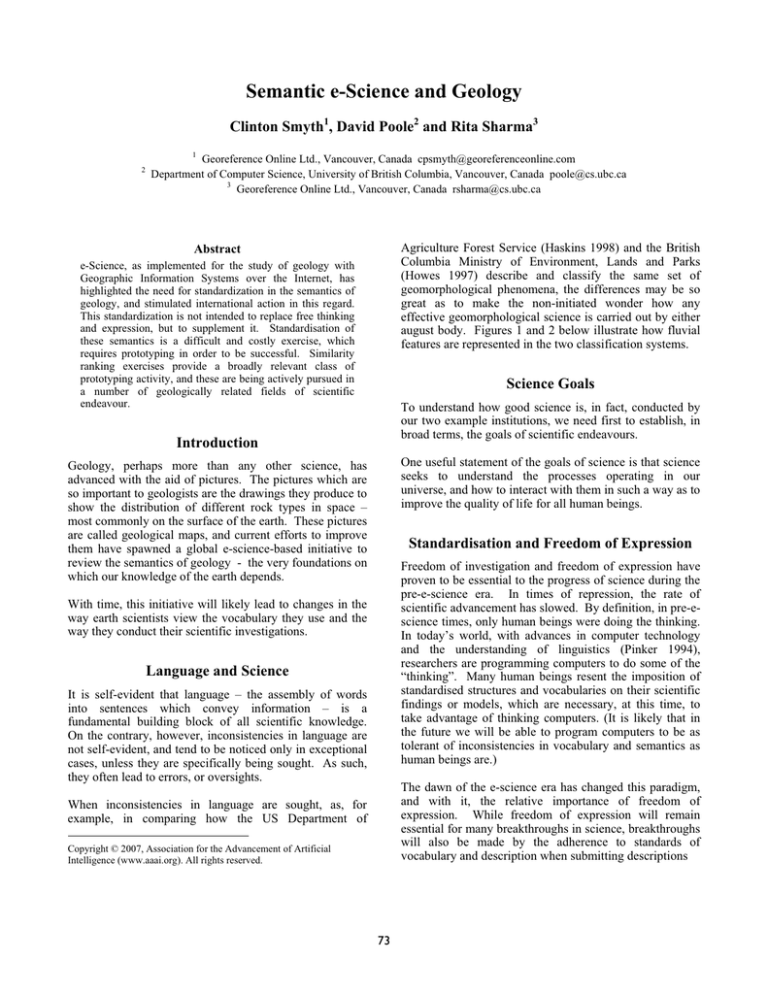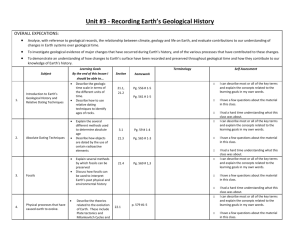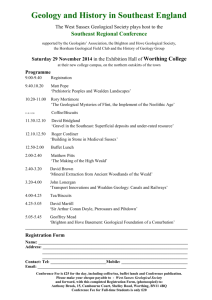
Semantic e-Science and Geology
Clinton Smyth1, David Poole2 and Rita Sharma3
1
2
Georeference Online Ltd., Vancouver, Canada cpsmyth@georeferenceonline.com
Department of Computer Science, University of British Columbia, Vancouver, Canada poole@cs.ubc.ca
3
Georeference Online Ltd., Vancouver, Canada rsharma@cs.ubc.ca
Agriculture Forest Service (Haskins 1998) and the British
Columbia Ministry of Environment, Lands and Parks
(Howes 1997) describe and classify the same set of
geomorphological phenomena, the differences may be so
great as to make the non-initiated wonder how any
effective geomorphological science is carried out by either
august body. Figures 1 and 2 below illustrate how fluvial
features are represented in the two classification systems.
Abstract
e-Science, as implemented for the study of geology with
Geographic Information Systems over the Internet, has
highlighted the need for standardization in the semantics of
geology, and stimulated international action in this regard.
This standardization is not intended to replace free thinking
and expression, but to supplement it. Standardisation of
these semantics is a difficult and costly exercise, which
requires prototyping in order to be successful. Similarity
ranking exercises provide a broadly relevant class of
prototyping activity, and these are being actively pursued in
a number of geologically related fields of scientific
endeavour.
Science Goals
To understand how good science is, in fact, conducted by
our two example institutions, we need first to establish, in
broad terms, the goals of scientific endeavours.
Introduction
One useful statement of the goals of science is that science
seeks to understand the processes operating in our
universe, and how to interact with them in such a way as to
improve the quality of life for all human beings.
Geology, perhaps more than any other science, has
advanced with the aid of pictures. The pictures which are
so important to geologists are the drawings they produce to
show the distribution of different rock types in space –
most commonly on the surface of the earth. These pictures
are called geological maps, and current efforts to improve
them have spawned a global e-science-based initiative to
review the semantics of geology - the very foundations on
which our knowledge of the earth depends.
Standardisation and Freedom of Expression
Freedom of investigation and freedom of expression have
proven to be essential to the progress of science during the
pre-e-science era. In times of repression, the rate of
scientific advancement has slowed. By definition, in pre-escience times, only human beings were doing the thinking.
In today’s world, with advances in computer technology
and the understanding of linguistics (Pinker 1994),
researchers are programming computers to do some of the
“thinking”. Many human beings resent the imposition of
standardised structures and vocabularies on their scientific
findings or models, which are necessary, at this time, to
take advantage of thinking computers. (It is likely that in
the future we will be able to program computers to be as
tolerant of inconsistencies in vocabulary and semantics as
human beings are.)
With time, this initiative will likely lead to changes in the
way earth scientists view the vocabulary they use and the
way they conduct their scientific investigations.
Language and Science
It is self-evident that language – the assembly of words
into sentences which convey information – is a
fundamental building block of all scientific knowledge.
On the contrary, however, inconsistencies in language are
not self-evident, and tend to be noticed only in exceptional
cases, unless they are specifically being sought. As such,
they often lead to errors, or oversights.
The dawn of the e-science era has changed this paradigm,
and with it, the relative importance of freedom of
expression. While freedom of expression will remain
essential for many breakthroughs in science, breakthroughs
will also be made by the adherence to standards of
vocabulary and description when submitting descriptions
When inconsistencies in language are sought, as, for
example, in comparing how the US Department of
Copyright © 2007, Association for the Advancement of Artificial
Intelligence (www.aaai.org). All rights reserved.
73
Figure 2. Part of the British Columbia Terrain
Classification System
As our study of the planet earth has become more holistic
in approach, these inconsistencies across provincial and
national boundaries have become a hindrance to the
advancement of geological understanding. This hindrance
is receiving more attention (BBC 2007) because e-science,
as delivered by a combination of Geographic Information
Systems (GIS) and the Internet, has made it so much more
visible, and provides some of the tools to remove it.
Figure 1. Part of the Landform Classification System
of the USDA Forest Service.
to computer “thinking” processes, which would otherwise
have taken much longer to be made.
Computers
processing very large consistently described data sets
makes possible the recognition of patterns otherwise
obscured by non-standard vocabulary.
Semantic e-Science and Geology
The first concerted international effort to address these
problems from an e-science perspective was initiated by 15
national geological surveys at a meeting in Edinburg,
Scotland, in 2003, co-hosted by the British Geological
Survey and the Geological Survey of Canada (Laxton
2004).
Geologists’ pictures are a fine example in this regard.
Geological Goals
Geology is the study of the solid, inanimate earth, and the
processes that operate on it. Research ranges in scale from
sub-microscopic to galactic.
At the meeting, entitled “The Geological Data Model
International Collaboration Inaugural Meeting”, the 15
countries agreed to develop together a standard model for
the expression of geological knowledge, particularly as it
pertains to geological maps.
When working at relatively large scales, geologists are
invariably dependent on data and information gathered and
reported by other geologists regarding smaller-scale
features that they may never see in reality. They will see
only the maps produced by their co-workers, and will
attempt to build new knowledge from these.
Three subsequent years of very active collaboration has
produced a well-documented and working version of
GeoSciML, which is defined as “a geoscience specific
XML-based GML (Geography Markup Language)
application that supports interchange of geoscience
information” (CGI 2007). One of the first science goals to
which GeoSciML is being applied is a complete
semantically consistent Internet-delivered geological map
of the world (PlanetEarth 2007).
e-Science and Geology
A consistent subject of scorn or jocularity in geology is the
omni-present “map-boundary fault”
an apparent
geological discontinuity along the boundary of adjoining
maps, which is invariably nothing more than a difference
in opinion or nomenclature between the individuals who
mapped each sheet.
74
There are four types of comparisons that experts need to
make:
Vocabularies need Ontologies
The collaborators have now turned their attention to
vocabulary - the words that they need to populate the
knowledge structures they have built (Richard 2006).
These knowledge structures may be considered as
“incomplete ontologies”, and are essential pre-requisites
for the production of vocabularies and semantics suitable
for e-science. Without them, it is not possible to efficiently
prototype candidate terms, taxonomies, partonomies and
more complex semantic structures than have already been
formalized.
Comparison Type
Example
Instance to many Models
Classification of a mineral
deposit
Generation of a landslide
hazards map
Development of a landslide classification system
Evaluation of competing
classification systems
Model to many Instances
Instance to many Instances
Model to many Models
Prototyping Semantics
Using ontologies which include standardized vocabularies
it is possible to automate the similarity ranking activity for
all four of the above comparison types.
Prototyping is typically an expensive activity. Prototyping
standardized languages is no exception in this regard, and
its high cost has held up the development of standardized
terminologies across institutions, national boundaries, and
across natural language groups.
Technologies for doing this in any domain are still in their
infancy, despite significant growth of interest in semantic
networks, and in ontologies over the last five years (Poole
and Smyth 2005). While technologies for semantic
descriptions exist and technologies for matching with
probabilities and qualitative probabilities exist, their
integration has been elusive.
Nevertheless prototyping is essential, with the consequence
that it is important to identify semantics prototyping
activities that have broad relevance. There is little sense in
spending large amounts of money on semantics that satisfy
niche activities, to the exclusion of broad scientific
interests.
Achieving success in this field depends on the solution of a
number of related scientific and technological problems.
These problems include the following:
We have identified the related activities of “comparison”
and “similarity ranking” as scientific activities of broad
relevance, and hence high potential for semantics
prototyping (Smyth and Poole 2004).
(1) How expert descriptions of instances and models
should be represented on the computer (issues attend
both description structure and vocabulary);
(2) How the user interface to such representations should
function so as to encourage expert and non-expert use
of the system;
(3) How the similarity rankings should be derived (there
are both user-dependent issues and user-independent
issues remaining to be addressed here);
(4) How to explain to the user, in an easily
understandable form, how similarity rankings were
derived (i.e.: to provide an audit trail of results);
(5) How to provide advice to the user on the most salient
information to gather to improve or reduce the quality
of a similarity measure, as is necessary when a user is
trying to distinguish between two close matches to his
instance or model of interest.
Comparison and Similarity Ranking
One of the most fundamental activities of an expert in any
field is that of comparison. An example is a doctor
comparing the symptoms of a sick person to her
knowledge base of illnesses when seeking a diagnosis. In
general, an expert compares one thing (the “in focus”
thing) to a number of other things, and ranks the latter
collection of things based on their similarity to the “in
focus” thing.
The faster and more reliably this job can be done, the better
the expert. There is often a tradeoff between speed and
reliability.
All of these are challenges facing semantic e-science.
There is a fundamental difference between “models”,
which are abstract concepts, and “instances”, which are
generally physical entities or events whose attributes can
be measured, and about which True/False statements can
be made. Equivalent statements about models, on the other
hand, need to be qualified with probability-type qualifiers,
such as “always”, “sometimes”, or “rarely”, rather than
with True/False truth-status qualifiers.
Vocabulary Prototyping Applications
Our research group is prototyping vocabularies for use in
e-science by developing web services which can be used to
store, compare, and rank on similarity, descriptions of
models and instances of mineral deposits (Smyth 2004),
landslides and landslide hazards (Smyth 2005a), and
plutons (Smyth 2005b). We are also prototyping the
75
matching of optimum extractive metallurgical processes to
ore types. The progression of these prototypes to thinking
computer systems which aid thinking human beings in
their pursuit of a better quality of life currently depends on
standardized vocabularies and ontologies, one of the key
current challenges to e-science.
Richard, S. 2006. Geologic Vocabularies and Reference
Systems
http://www.seegrid.csiro.au/twiki/view/CGIModel/
GeologicVocabulary
Smyth, C. 2004 MineMatch
http://www.georeferenceonline.com/ref/MineMatch2004/
MineMatch2004.html
Conclusion
Smyth, C. 2005a The Role of Geological Terminology in
Working with Landslides and Landslide Models
Presentation to the Geological Survey of Canada Ottawa,
Canada.
http://www.gomatcher.com/ppt/HazardMatchOttawa02/
HazardMatchOttawa02.html
There exists, in the use of e-science technologies, a tension
between the need to standardize and the need for freedom
of expression. Large scale geological mapping presents a
compelling example of the benefits of standardization.
The potential rewards of standardising how knowledge is
represented on computers are greater than they ever were
before, and this is causing much costly effort to be invested
in developing ontological standards, including vocabulary
standards. Comparison and similarity ranking activities are
appropriate contexts within which to refine prototype
semantics for use in various aspects of e-science.
Smyth, C. 2005b Researching Continental Evolution with
Computer-Assisted Comparisons and Similarity-Rankings
of Plutons Abstracts of the Geological Society of America
Annual Meeting, Salt Lake City, Utah.
http://gsa.confex.com/gsa/2005AM/finalprogram/
abstract_94831.htm (includes slides)
References
Smyth, C. P. and Poole, D. 2004. Qualitative Probabilistic
Matching with Hierarchical Descriptions in Proceedings
of the Ninth International Conference on Knowledge
Representation
and
Reasoning
(KR2004)
http://www.aaai.org/Library/KR/kr04contents.php
BBC 2007.
http://news.bbc.co.uk/2/hi/science/nature/6434011.stm
CGI 2007. http://www.cgi-iugs.org (2007)
Haskins, Donald M..; Correll, Cynthia S.; Foster, Richard
A.; Chatoian, John M.; Fincher, James M.; Strenger,
Steven; Keys, James E. Jr.; Maxwell, James R.; King,
Thomas. 1998. A Geomorphic Classification System,
version 1.4. Washington, DC: U.S. Department of
Agriculture, Forest Service. 130 p.
Howes, D. E. and Kenk, E. 1997 A System for the
Classification of Surficial Materials, Landforms and
Geological Processes of British Columbia (Version 2)
http://ilmbwww.gov.bc.ca/risc/pubs/teecolo/terclass/cove1.
htm
Laxton, J. 2004. Geological Data Model International
Collaboration: Report on the Inaugural Meeting
http://www.bgs.ac.uk/cgi_web/tech_collaboration/data_mo
del/docs/inaugural.html
Pinker, S. 1994. Chapter 4: How Language Works in
The Language Instinct published by HarperCollins ISBN:
978-0060976514
Poole, D. and Smyth C. P. 2005. Type Uncertainty in
Ontologically-Grounded
Qualitative
Probabilistic
Matching Proceedings of the Eighth European Conference
on Symbolic and Quantitative Approaches to Reasoning
with Uncertainty (ECSQARU-2005) Barcelona, Spain
PlanetEarth 2007. http://www.bgs.ac.uk/onegeology
76



